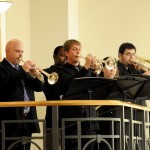Music for a New Millennium Liner Notes
Music for a New Millennium
Sonata for Trombone and Piano (2009) Dan Forrest (b.1978) C. Alan Publications
I. Andante Maestoso
II. Lento, molto espressivo
III. Allegro vivace
Recorded April 26, 2008 at Stratton Hall, Bob Jones University, Greenville, SC. Ryan Wooldridge, engineer. Paul Overly, producer. Mike Hall, trombone. Daniel Overly, piano.
Dan Forrest is a gifted composer whose work is defining the sound of the new millennium, especially in the choral world. Sonata for Trombone and Piano was written in the spring of 2005, as the result of a trombonist friend’s suggestion. The first movement contrasts an angular, aggressive theme with a more lyrical theme. After an intense, rhythmic development, the themes are recapped in reverse order, before a coda recalls the previous rhythmic section. The second movement, in ABA form, presents a long-breathed lyrical melody that unfolds farther and farther with each repetition. The third movement is a lively, humorous rondo with three themes that are more closely related than they might first appear. After a trombone cadenza, the themes return, first rudely interrupting each other, then all jumbling together in an exuberant coda. This is music of great beauty and sophistication.
Sonata for Trombone and Piano (2009) Robert Hanson (b.1946)
I. Allegro moderato
II. Adagio
III. Allegro moderato
Recorded June 22, 2009 at Solid Sound Studios, Ann Arbor, MI. Eric Wojahn, engineer. Robert Hanson, producer. Mike Hall, trombone. James Wilhelmsen, piano.
Robert Hanson conducted the Elgin Symphony in Illinois for decades. I came to know him as a composer when he joined the faculty of the Iron County Band Camp in Michigan, where we have taught together for 19 years. I have admired his special ability to write for young musicians. In 2009 I asked Bob to write a sonata for trombone and piano, something accessible to younger trombonists, but that exploits qualities that trombones do so well… make sound, play lyrically and powerfully. He responded with a wonderful sonata that we premiered at the camp in 2010 and recorded the next week. In the first movement, a simple, lyrical trombone melody is interwoven with undulating piano writing that ingeniously and simultaneously incorporates duple and triple meters. From the midst of this emerges a swinging jazz melody that leads to a heroic moment before melting slowly into the second movement. Similar lyrical and metric gestures continue here on a new theme but it all has a hint of scherzo diversion about it – cleverness disguised with subtlety. The last movement brings back all the previous material but on a more playful canvas and with a new, dancing theme. This is a modern sonata with classic underpinnings that utilizes a pleasing vocabulary.
Three Admirations (2005) Daniel Kallman (b.1956) Kallman Creates Publications
I. Reverence
II. Nurturance
III. Exuberance
Recorded Oct 12, 2008 at Chandler Recital Hall, Old Dominion University, Norfolk, VA. Steve Latham, engineer/producer. Mike Hall, bass trombone. Oksana Lutsyshyn, piano.
Daniel Kallman’s compositions are widely published and performed. His steady stream of commissions includes music for worship, theater, dance, and the young musician. Of his Three Admirations Kallman writes: I was originally contacted by [friends] Bill and Laura Behrens in late 2003 with the offer of a commission to present as a gift to [their son] Christian for his senior recital… I had begun some ideas for a sonata… when the tragic accident that ended Bill’s life occurred the following spring. After that, the work took on a whole new form and focus as a memorial to Bill and his legacy…
The opening movement is a serene meditation that explores the emotions of loss, grief, resignation and grateful acceptance. The tone of the music is intentionally ‘sacred,’ at times almost choral or chant like. The content of the middle movement was inspired by what I have come to know and respect about Bill as father, scout leader and teacher. It incorporates three distinct sections indicated in the score by the subtitles Lullaby, At Play, and Gratitude. The last is again hymn like, but less meditative and more a lifting up of thanks and praise. Each section employs canonic counterpoint where the trombone imitates what the piano has just played or vice versa, indicating that the student not only learns from the teacher, but the reverse is often true. The lullaby links the sections and returns to close the movement. The final movement has the feel and tone of a circus march, a deliberately boisterous outburst of joy with humorous overtones. This is the freewheeling and fun Bill Behrens whom I was blessed to know…
Sonata for Trombone and Piano (2005) Joseph Trapanese (b.1984)
I. Allegro marcato
II. Canzone
III. Fuga
Recorded October, 2008 at Chandler Recital Hall, Old Dominion University, Norfolk, VA. Steve Latham, engineer/producer. Mike Hall, trombone. Oksana Lutsyshyn, piano.
Currently working in Los Angeles, Joseph Trapanese writes music for film, television and concerts. His sonata can be understood as part of a compositional trend that emerged from the last century, a sound characterized by functional, grounded harmony, standard rhythms and romantically conceived phrases, both lyrical and technical. However, it also incorporates extreme melodic leaps together with extreme dynamic contrasts, which significantly elevates its difficulty level. This is fine writing, inventive, concise, expressive.
Rapsodie Armoricaine (1999) Marc Lys (b.1963) Editions Combre
Recorded September 19, 2008 at Solid Sound Studios, Ann Arbor, MI. Eric Wojahn, engineer/producer. Mike Hall, trombone. James Wilhelmsen, piano.
In The Morning (1896) Paul Laurence Dunbar (1872-1906)
Recorded December 28, 2011 in Chandler Recital Hall, Old Dominion University, Norfolk, VA. Steve Latham, engineer/producer. Dora Granby, spoken word.
French composer Marc Lys and American poet Paul Dunbar live a continent and a century apart, yet these two completely unconnected works seem tailor made for one another. Lys draws on mysterious, foggy lamentation, modern funk/rock and jazz waltz sounds, all set apart from one another in rather stark sections that seem to embody the attitude of the sleepy, then agitated, then defiant Elias in Dunbar’s poem.


